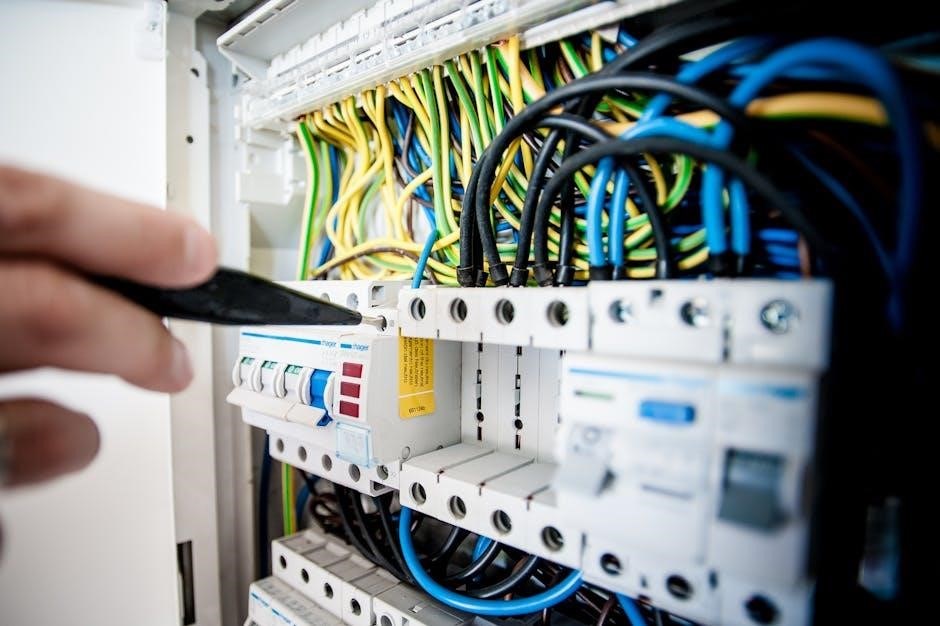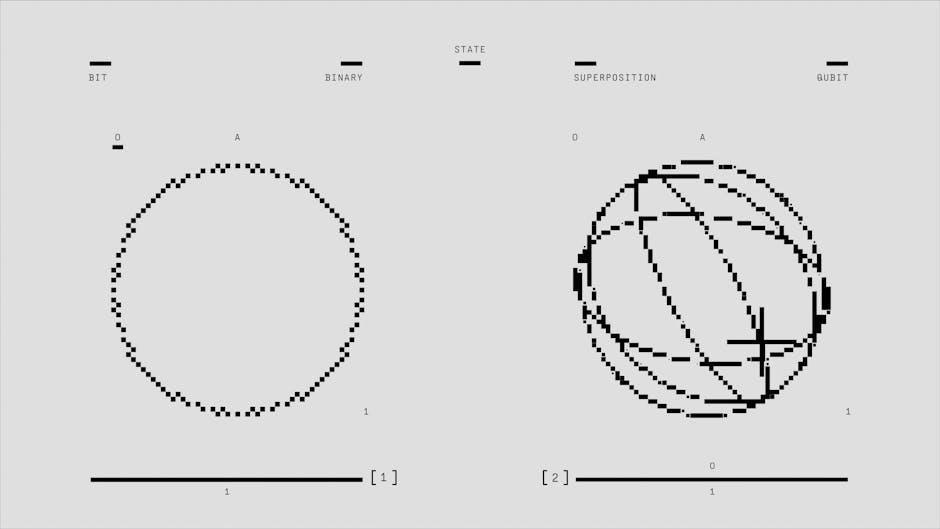Yamaha outboard wiring diagrams provide a detailed visual representation of electrical systems, essential for troubleshooting, repairs, and installations. They guide users through complex circuits and connections effectively.
1.1 Overview of Yamaha Outboard Motors
Yamaha outboard motors are renowned for their reliability, performance, and innovative technology. With a wide range of models catering to various boating needs, these motors deliver exceptional power and efficiency. From compact portable engines to high-performance V6 models, Yamaha outboards are designed to meet the demands of both recreational and commercial marine applications. Their advanced features, such as digital controls and fuel injection systems, ensure optimal performance and fuel efficiency. Yamaha’s commitment to quality and innovation has made them a trusted choice among boating enthusiasts worldwide. Understanding the electrical systems of these motors is crucial for maintenance and repairs, making wiring diagrams an indispensable resource for owners and technicians alike.
1.2 Importance of Wiring Diagrams for Maintenance and Repair
Wiring diagrams are essential for maintaining and repairing Yamaha outboard motors, as they provide a clear map of the electrical system. These diagrams help identify wire colors, connections, and components, making troubleshooting easier. Whether diagnosing no-crank issues, tachometer problems, or ignition faults, a wiring diagram is crucial for pinpointing faults quickly. It ensures that repairs are done correctly, preventing further damage or safety hazards. By understanding the circuit pathways, technicians and DIY enthusiasts can safely perform upgrades or installations. Regular maintenance also benefits from these diagrams, as they guide routine checks and part replacements. Ultimately, wiring diagrams save time, reduce costs, and enhance safety when working with complex electrical systems.

Understanding Yamaha Outboard Wiring Diagrams
Yamaha outboard wiring diagrams simplify complex electrical systems, offering clear visuals of components, connections, and circuits. They enable users to identify functions, troubleshoot issues, and perform repairs efficiently.
2.1 Key Components of a Yamaha Outboard Wiring Diagram
A Yamaha outboard wiring diagram typically includes essential components such as the battery, starter motor, ignition switch, gauges, and electronic control units. These diagrams also highlight circuit connections, fuses, and relays, providing a clear pathway for electricity flow. Additionally, they feature color-coded wires, which indicate specific functions, and connectors that link various system parts. The diagrams often outline the ignition system, including the CDI box and spark plugs, as well as the fuel injection system for modern models. Understanding these components is crucial for diagnosing issues like no-crank scenarios or malfunctioning gauges, ensuring proper repairs and maintenance.
2.2 Common Symbols and Terminology Used
Yamaha outboard wiring diagrams utilize standardized symbols and terminology to ensure clarity. Common symbols include circles representing connectors, rectangles for components like relays or fuses, and lines indicating wires. Terminology such as “V” for voltage, “GND” for ground, and “IGN” for ignition is frequently used. Wire colors are also standardized, with red often indicating positive power, yellow for ignition circuits, and black/white for ground connections. Understanding these symbols and terms is crucial for interpreting the diagrams accurately. They help identify circuit pathways, troubleshoot issues like no-start conditions, and ensure safe electrical modifications or repairs.

How to Find a Yamaha Outboard Wiring Diagram
Locate Yamaha outboard wiring diagrams through official Yamaha resources, service manuals, or online forums. Websites like Yamaha Marine, PDF repositories, and marine dealer networks often provide these documents.
3.1 Official Yamaha Resources and Manuals
Yamaha provides official wiring diagrams and service manuals for their outboard motors through their website and authorized dealers. These resources are the most reliable, offering accurate and detailed schematics tailored to specific models. Owners can access these materials by visiting the Yamaha Marine website or consulting their owner’s manual. Additionally, Yamaha service manuals, available in PDF format, include comprehensive wiring diagrams, torque specifications, and troubleshooting guides. These documents are essential for maintaining and repairing Yamaha outboard motors, ensuring safety and optimal performance. By referencing official Yamaha resources, users can avoid errors and ensure compliance with manufacturer recommendations.
3.2 Online Communities and Forums

Online forums and communities are invaluable resources for finding Yamaha outboard wiring diagrams. Websites dedicated to marine enthusiasts and Yamaha owners often share PDFs and schematics, offering practical solutions to common issues. Users frequently post their experiences, including diagrams and step-by-step guides, helping others troubleshoot problems like no-crank issues or gauge malfunctions. Platforms such as the Yamaha Outboard Forum and Reddit communities provide a wealth of knowledge, with members sharing their expertise and repair tips. These forums also serve as a platform for requesting specific wiring diagrams, fostering collaboration and support among boat owners and technicians.
3.3 Third-Party Websites and PDF Repositories

Third-party websites and PDF repositories are another reliable source for Yamaha outboard wiring diagrams. Websites like Scribd, ManualsLib, and various marine equipment forums often host downloadable PDFs of wiring diagrams for different Yamaha outboard models. These resources are particularly useful when official manuals are unavailable or difficult to obtain. Additionally, auction sites like eBay may offer service manuals or wiring diagrams for specific Yamaha outboard engines. While these sources can be helpful, it’s essential to verify the accuracy and compatibility of the diagrams with your engine model and year. Always ensure the source is reputable to avoid downloading incorrect or incomplete information.

Reading and Interpreting the Wiring Diagram
Wiring diagrams reveal circuit pathways, wire colors, and component connections. They help diagnose issues like no-crank scenarios and tachometer malfunctions, ensuring precise electrical system repairs.
4.1 Identifying Wire Colors and Their Functions
Wire colors in Yamaha outboard diagrams indicate specific functions, such as power, ground, or signal. For instance, black wires often serve as ground connections, while red wires typically carry positive power. Yellow wires may signify ignition circuits, and green wires could represent tachometer signals. Understanding these color codes is crucial for accurate diagnostics and repairs. By referring to the wiring diagram, users can trace each wire’s path and purpose, ensuring correct connections and avoiding electrical damage. This systematic approach simplifies complex electrical systems, making it easier to identify faults and perform necessary modifications or upgrades effectively.
4.2 Understanding Circuit Connections and Pathways
Yamaha outboard wiring diagrams illustrate how electrical components are interconnected, detailing the flow of power and ground paths. By tracing these connections, users can identify how circuits interact, from the battery to the ignition switch, ECU, and sensors. This understanding is critical for diagnosing issues like no-crank conditions or tachometer malfunctions. The diagrams reveal the sequence of connections, helping users pinpoint breaks or short circuits in the wiring. This knowledge enables precise troubleshooting and ensures that repairs are made safely and effectively, avoiding potential electrical damage. By following the circuit pathways, users can confidently address complex problems and perform modifications with accuracy. This step-by-step approach simplifies even the most intricate electrical systems, making repairs accessible for both novice and experienced technicians alike.

Common Issues Solved by Wiring Diagrams
Yamaha outboard wiring diagrams help resolve issues like no-crank conditions, tachometer malfunctions, and ignition faults by providing clear pathways to trace and repair electrical systems effectively.
5.1 Diagnosing No-Crank or No-Start Issues
Yamaha outboard wiring diagrams are indispensable for diagnosing no-crank or no-start issues. By analyzing the ignition circuit, users can identify faults in switches, relays, or solenoids. Checking the battery and starter connections is crucial, as poor contacts often cause failure. The diagram helps trace the kill switch wiring and ensures the lanyard is properly connected. For spark issues, disconnecting the white wire from the CDI box and testing ignition coils can reveal problems; Additionally, verifying the starter solenoid’s functionality and ensuring proper ground connections are essential steps guided by the wiring diagram. These visual aids simplify troubleshooting, helping users isolate and resolve electrical faults efficiently.
5.2 Troubleshooting Tachometer and Gauge Problems
Yamaha outboard wiring diagrams are vital for troubleshooting tachometer and gauge malfunctions. Common issues include faulty connections, incorrect wiring, or damaged sensors. Users can verify signal wires connected to the tachometer, ensuring they match the diagram. For example, the tach signal wire on the F115 model must be correctly identified to resolve meter inaccuracies. Gauges may malfunction due to improper grounding or corroded terminals, which the diagram helps locate. Testing voltage levels with a multimeter, as guided by the wiring layout, can pinpoint faulty circuits. Additionally, the diagram clarifies wiring for aftermarket gauges, ensuring compatibility with Yamaha’s electrical system. By following the diagram’s instructions, users can restore accurate readings and functionality to their instruments.

5.3 Resolving Ignition System Faults
Yamaha outboard wiring diagrams are essential for diagnosing ignition system issues, which can prevent the engine from starting or running smoothly. Common faults include faulty spark plugs, ignition coils, or kill switches. The diagram helps identify the ignition circuit, allowing users to trace wires and verify connections. For example, disconnecting the white wire from the CDI box and testing for spark can reveal ignition coil problems. Additionally, the diagram guides users in checking the kill switch circuit, ensuring it grounds properly when activated. By referencing the wiring layout, users can isolate issues like faulty sensors or corroded connectors, ensuring the ignition system functions correctly and safely.

DIY Projects Using Yamaha Outboard Wiring Diagrams
Yamaha outboard wiring diagrams enable enthusiasts to tackle DIY projects confidently, such as installing aftermarket gauges or upgrading electrical systems for modern accessories, ensuring seamless integration and functionality.
6.1 Installing Aftermarket Gauges and Instruments
Installing aftermarket gauges and instruments on your Yamaha outboard can enhance performance monitoring and customization. Begin by consulting the wiring diagram to identify the correct wire colors and their functions. Common wires include power, ground, and sensor inputs. Ensure all connections are secure and match the diagram’s specifications. For tachometers, locate the tach signal wire, often linked to the engine’s ignition system. Proper installation requires careful planning and adherence to the wiring diagram to avoid electrical damage. Test each connection before powering up to ensure accuracy. This upgrade not only improves functionality but also personalizes your outboard’s control system for optimal user experience.
6.2 Upgrading Electrical Systems for Modern Accessories
Upgrading your Yamaha outboard’s electrical system for modern accessories like LED lights, GPS, or fish finders requires a thorough understanding of the wiring diagram. Start by identifying the existing circuits and their capacities. Plan the upgrade by mapping out the new components and their power requirements. Disconnect the battery before beginning work to ensure safety. Use the wiring diagram to locate suitable connection points and ensure all new wires are properly sized and insulated. Install marine-grade components to withstand harsh environments. Test each accessory individually after installation to verify functionality. This process ensures a reliable and efficient electrical system, ready for modern marine electronics.
Safety Tips When Working with Wiring Diagrams
Always disconnect the battery and ensure power is off before starting work. Use insulated tools to prevent shocks and consult the Yamaha manual for guidance.
7.1 Essential Tools and Equipment for Safe Wiring
When working with Yamaha outboard wiring diagrams, essential tools include multimeters, wire strippers, and crimpers; A heat gun is useful for heat-shrink tubing, while insulated pliers and screwdrivers prevent electrical shock. Circuit testers and LED light clips help identify live wires safely. A digital multimeter is crucial for diagnosing voltage and resistance issues. Proper protective gear, like gloves and safety glasses, should always be worn. Ensure all tools are rated for marine environments to withstand corrosion. A well-lit workspace and a clean, stable surface are also vital for accurate and safe wiring work. Referencing the Yamaha manual alongside these tools ensures compliance with manufacturer guidelines.
7.2 Best Practices for Avoiding Electrical Damage
To prevent electrical damage when working with Yamaha outboard wiring diagrams, always disconnect the battery before starting. Use marine-grade components and follow proper soldering techniques. Avoid mixing old and new wires, as this can cause corrosion. Regularly inspect connectors for wear and replace them if necessary. Ensure all grounds are clean and secure. Never overload circuits or use incorrect fuse ratings. Keep wiring away from heat sources and moving parts. Follow the diagram precisely, and double-check connections before powering up. Using the correct tools and adhering to safety protocols minimizes risk. Consulting Yamaha manuals or a certified technician is recommended for complex tasks. These practices ensure reliable performance and longevity of your electrical system.

Resources and Support for Yamaha Outboard Owners
Yamaha offers extensive resources, including official manuals, PDF guides, and online forums, to assist owners with wiring diagrams, troubleshooting, and maintenance of their outboard motors.
8.1 Yamaha Service Manuals and Guides
Yamaha service manuals and guides are indispensable resources for outboard motor owners, providing detailed instructions for maintenance, repairs, and troubleshooting. These manuals include wiring diagrams, torque specifications, and step-by-step procedures to ensure proper servicing. Available in PDF format, they can be downloaded from Yamaha’s official website or purchased through authorized marine dealers. The guides cover various models and years, making them a valuable tool for both professional technicians and DIY enthusiasts. They also offer insights into diagnosing common issues, such as no-crank problems or gauge malfunctions, and provide exploded views of components for easier identification. By following these manuals, owners can maintain their outboards efficiently, ensuring optimal performance and longevity.
8.2 Marine Dealer and Technician Recommendations
Consulting a certified Yamaha marine dealer or technician is highly recommended for accurate wiring diagram interpretation and troubleshooting. These professionals have extensive experience with Yamaha outboard systems and can provide tailored advice for specific models. Dealers often have access to official resources and can supply precise wiring diagrams or repair guides. Technicians can diagnose complex electrical issues, ensuring repairs are done safely and correctly. For DIY enthusiasts, they offer valuable insights and tips, such as proper tools and techniques for handling wiring. Regular consultations with experts help maintain the outboard’s performance and prevent future issues. Their knowledge ensures compliance with Yamaha’s standards, enhancing reliability and longevity of the motor.
